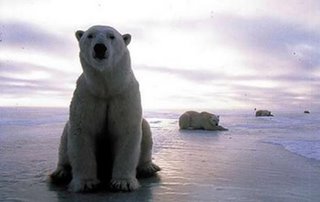Ursus Maritimus, Polar Bear Apocalypse
http://news.nationalgeographic.com/news/2006/02/0210_060210_polar_bear_video.html
"But for all their strength, specialisation and wiles, polar bears are in trouble as their habitat deteriorates."

"[Global climate change] extended the ice-free summer by three weeks. And every week cuts the amount of fat a bear will have accumulated by the onset of winter by 10kg to 20kg. As females don't eat for the eight months of their pregnancies, relying entirely on stored fat, this trend could have a catastrophic effect on the species' reproduction. You're not going to have sea ice in summer in the
 Arctic well before the end of the century, and some time around then you're not going to have polar bears"
Arctic well before the end of the century, and some time around then you're not going to have polar bears""What is the point of preserving a species if there's nowhere for them to go except to be driven to madness?"
"Perhaps in the future, children will look back on the fabled polar bears of the icy North Pole the way we imagine woolly mammoths in the last Ice Age. Only this time, we will know who is to blame."

